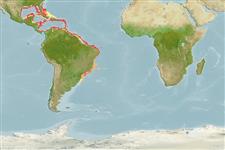Common names from other countries
>
Perciformes/Serranoidei (Groupers) >
Anthiadidae (Fairy basslets or Streamer basses)
Etymology: Pronotogrammus: Greek, pro = first, in front of + Greek, noton = back + Greek, gramma = signal, letter (Ref. 45335).
More on author: Guichenot.
Environment: milieu / climate zone / depth range / distribution range
Ecología
marino demersal; rango de profundidad 65 - 230 m (Ref. 34841). Tropical; 32°N - 36°S
Western Atlantic: Florida, USA and Bermuda through the Greater Antilles to Rio Grande, Brazil (Ref. 47377).
Tamaño / Peso / Age
Maturity: Lm ? range ? - ? cm
Max length : 20.0 cm TL macho / no sexado; (Ref. 7251); common length : 16.0 cm TL macho / no sexado; (Ref. 5217); edad máxima reportada: 15 años (Ref. 96848)
Espinas dorsales (total) : 10; Radios blandos dorsales (total) : 13 - 16; Espinas anales: 3; Radios blandos anales: 7 - 8; Vértebra: 26.
Adults are commonly found on outer continental shelf reefs. They primarily feed on zooplankton while common in the diet of larger predators like snappers and groupers (Ref. 96848).
Are monandric (males are secondary), protogynous hermaphrodites. About 50% of females transform into males at 7.63 cm SL and 1.0 yr of age (Ref. 96848). During the spawning period, oocytes are found to be in different stages of development indicating asynchronous oocyte development and indeterminate fecundity (Ref. 96848).
Anderson, W.D. Jr. and P.C. Heemstra, 1980. Two new species of Western Atlantic Anthias (Pisces: Serranidae), redescription of A. asperilinguis and review of Holanthias martinicensis. Copeia 1980(1):72-87. (Ref. 34841)
IUCN Red List Status (Ref. 130435)
CITES (Ref. 128078)
Not Evaluated
Threat to humans
Harmless
Human uses
Pesquerías: sin interés
Herramientas
Special reports
Download XML
Fuentes de Internet
Estimates based on models
Preferred temperature (Ref.
115969): 17.3 - 25.8, mean 21.2 (based on 86 cells).
Phylogenetic diversity index (Ref.
82804): PD
50 = 0.6250 [Uniqueness, from 0.5 = low to 2.0 = high].
Nivel trófico (Ref.
69278): 3.5 ±0.5 se; based on size and trophs of closest relatives
Resiliencia (Ref.
120179): Medio, población duplicada en un tiempo mínimo de 1.4-4.4 años (Preliminary K or Fecundity.).
Fishing Vulnerability (Ref.
59153): Low vulnerability (22 of 100).
